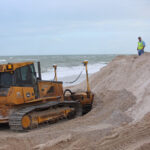By Lisa ZahnerINDIAN RIVER COUNTY — In a 4-0 decision with Chairman Wesley Davis abstaining from voting or participating in the more than three hours of discussion, the Board of County Commissioners has chosen to stick with its choice of upland sand contractor Ranger Construction. The decision came despite the possibility that the county may be forced to place up to 26 percent less sand on the beach. Commissioners directed staff and consultant Michael Walther of Coastal Tech to move forward with modifications to the permit application to renourish 6.6 miles of shoreline from Treasure Shores Park to John’s Island. Also in the motion were instructions to go back to the drawing board, working with all the stakeholders in the project to find a way, in the future if necessary, to produce a better quality sand to supplement the base project. “The staff needs to work with the sand mines, with the legislative delegation and with the governor, if necessary to get the permits and to try to get as close to the 470,000 cubic yards as possible,” said Commissioner Gary Wheeler, who made the motion, seconded by Commissioner Joe Flescher, who was acting as chair of the board at the time.The commissioners faced the possibility of having to revert to an off-shore sand source of pumped-in material to get the full amount of sand on the beach. Sand mine operators expressed appreciation for the commissioners’ determination to create a solution which would keep the $7 million contract and and untold number of jobs in the county.”We’ve had every possible roadblock put in our path, but by the good graces of you five gentlemen, we were able to continue in this process,” said Chuck Kramer, who has been a constant presence at meetings regarding the beach renourishment project.The decision to proceed with the trucked-in sand could result in delaying permits and pushing the start date of the project past the point where it could be accomplished before May 1. Construction can only be done between Nov. 1 and May 1 as to not disturb sea turtles during nesting season.Florida Department of Environmental Protection Beaches and Coastal Systems Programs Administrator Robert Brantly was available via telephone during the discussion to answer questions and to advise commissioners on the possible consequences of their decision. Permitting must be approved not only by DEP, but also by the U.S. Army Corps of Engineers and must pass muster with the Florida Fish and Wildlife Service as well.”They’re going to start a new regulatory clock on each of the two permit modifications,” said Brantly, expressing his professional opinion of how the county’s approach could get sidetracked. “It would be too late to construct before turtle nesting season in 2010.”The size, quality and projected performance of the upland sand, when run through computer models, produced a project design that would greatly reduce the volume of sand that could be placed on some of the most eroded portions of the beach, including Sea Oaks and the area of Orchid and Disney’s Vero Beach Resort.Brantly made it clear that his agency would not bend the rules as they relate to the construction project and the way it might impact the near-shore reef that spans the length of the county’s beaches.Coastal Tech will submit permit applications that allow for the 26 percent less sand to go on the beach in the initial phase of the project and go back to work with sand mine operators to identify more compatible sources of sand. The better sand could then be added to the base, to bring the amount of sand closer to the 478,000 cubic yards of sand ithe original design called for.Representatives from Stormwater and Underground, the low bidder that was not chosen by the county and later filed suit and appealed the decision, urged commissioners that they could have avoided the issues of reduction of sand by choosing their sand source, the Brian Davis Sand Mine. Commissioners rejected this assertion.
Privacy Policy | Copyright © 2024 32963 Media LLC All rights reserved | Contact: info@veronews.com | Vero Beach, Florida, USA | Orlando Web Design by: M5





